

“Your website showcases your expertise. Your content demonstrates your value. But your onboarding process? That’s where clients really find out if you’ve got your act together.”
That’ what Greg Mount says on his podcast Smart Solo Practice.
And we couldn’t agree more with him!
No matter how powerful a tool is, its impact is limited if it isn’t introduced effectively.
A well-designed software onboarding process ensures the technology is understood, embraced, and delivers real value.
And this is your guide to software onboarding; buckle up, we’re getting started.
TL;DR
- Software onboarding is the process of guiding users (specifically, employee-type users) through a new tool or platform so they can understand, adopt, and use it with confidence.
- Good software onboarding is important, as it ensures:
- Shorter and more effective employee training
- Higher productivity and workflow efficiency
- Smoother change management and digital adoption
- However, achieving these outcomes isn’t always easy. There are pitfalls to avoid when creating and managing your software onboarding, such as:
- Poor self-serve support and lack of additional resources
- Lack of contextual in-app guidance
- Information overload
- Lack of user motivation, tool burnout, and resistance to change are also among the common challenges you need to overcome with your software onboarding if you want successful adoption.
- So, how can you avoid these pitfalls and deliver a stunning onboarding experience? By following best practices, of course. Here they are:
- Breaking down long and complicated onboarding flows with checklists and interactive guides
- Tailoring the onboarding experience based on employee roles, workflows, and use cases
- Offering additional support through tooltips, hotspots, and in-app resource centers
- Collecting feedback and optimizing flows continuously
- UserGuiding can help you with all of these! In just minutes (and without writing a single line of code), you can create interactive, personalized, and engaging software onboarding experiences.
What is software onboarding?
Software onboarding is the process of helping employees get comfortable with a new digital tool and start using it in their everyday work. It’s a type of user onboarding (very specific to employees, though), and it overlaps with employee onboarding, but it is not identical.
The definition will make more sense once we unpack the differences, so stay with us.
User onboarding is a broad umbrella term.
It covers guiding anyone (customers, trial users, clients, or employees) through learning how a product works and why it’s valuable.
Software onboarding narrows that focus. It’s about employee users, and more specifically, how different teams or individuals can weave a particular tool into their workflows.
So, does that make it the same as employee onboarding? Well… only partly.
Employee onboarding is a much bigger process. It introduces new hires not only to the tools but also to the company culture, team dynamics, and role expectations. Software onboarding may fall inside that journey, but it also stands on its own.
That’s because software onboarding doesn’t just happen with new hires.
Software onboarding is equally critical for existing employees whenever the organization adopts new software or replaces old systems.
A new project management tool, a new CRM, or a new communication platform, all of these require onboarding moments, even for employees who’ve been around for years.

There’s one more distinction worth making: software onboarding versus software adoption. These two are also closely linked, but again, they’re not the same.
Software adoption is the full journey of embedding a new tool into an organization.
It stretches from the early planning and tool evaluation stages, to rollout strategies, to measuring long-term usage and customer success. In some cases, it even involves external consultants or adoption specialists who help manage the transition at scale.
Software onboarding is the in-app stage of this adoption journey.
Employees are guided inside the software, where they learn how to use features, set up workflows, and translate the tool’s potential into actual day-to-day value.
So, in short:
👉🏻 Software onboarding is similar to user onboarding but far removed from customer onboarding.
👉🏻 Employee onboarding is the initial onboarding process of new hires, while software onboarding happens both during new hire onboarding as well as during digital transformation.
👉🏻 Software onboarding is the in-app training portion of software adoption.
With all this information in mind, here’s an example software onboarding flow:
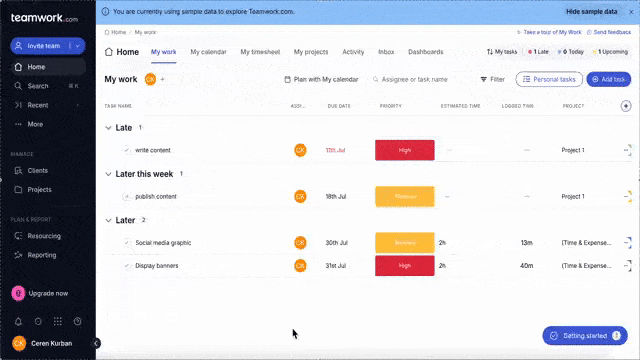
Why is software onboarding important?
Digital transformation has a notorious track record. Depending on which research you look at, somewhere between 70% and 95% of initiatives fail. And one of the biggest culprits is employee resistance.
When employees feel vulnerable, whether because they lack the skills to use new tools effectively or because they fear being replaced by them, they naturally push back.
💡 Think about it.
If someone doesn’t feel confident in their ability to handle a tool, their instinct is to avoid it, fall back on old methods, or quietly wait it out until the “new shiny thing” goes away.
But the fear that software will replace people usually isn’t grounded in reality. Most tools are built to support employees, not replace them.
A task management platform doesn’t eliminate the need for team leaders, a design tool doesn’t make designers obsolete, social media scheduling tools don’t remove the need for marketers, and even the most advanced CRM doesn’t replace sales or customer success teams.
These tools empower real human employees.
So, where does all the frustration come from? Most of the time, it’s not the software. It’s the lack of training.
👉🏻 Without proper onboarding, employees don’t know what the tool can do, what it can’t do, or how it fits into their daily work. That uncertainty breeds anxiety, which turns into resistance.
Do you see where this is going?
With software onboarding, you remove the mystery.
You give employees the context, the skills, and the confidence they need to use the tool effectively. They stop worrying and start seeing how the tool can actually help them do better work.
Here are other reasons why software onboarding is crucial:
Improves time and effort spent on employee training
Every new tool demands learning, but without structure, that learning becomes chaotic.
Employees spend hours experimenting, asking colleagues for help, or even Googling answers that may or may not apply. A well-designed and efficient onboarding process compresses this messy trial-and-error phase.
With (preferably automated) software onboarding, employees are guided through what matters most for their role instead of drowning in information.
Eases the off-app processes
As we said earlier, onboarding is only one part of the software adoption journey.
Beyond the initial onboarding, there are team check-ins, onboarding progress reviews, and even all-hands meetings designed to reinforce adoption.
The quality of in-app onboarding directly affects how effective these off-app processes are. When employees already understand the basics inside the software, the rest of the journey runs more smoothly.
Engagement meetings, for example, don’t have to waste time on how to generate a simple report. Instead, managers can focus on why those reports matter and how they connect to business goals.
Supplementary training platforms, progress dashboards, and peer-support initiatives also become far more impactful once employees have a solid foundation from the in-app experience.
Boosts company culture
Going through a structured learning experience together can bring internal teams closer. It creates shared language and shared wins, especially when everyone is learning a new tool at the same time.
Even when the onboarding doesn’t happen in one big conference room.
Even for remote teams.
A digital onboarding experience, paired with open communication channels, helps prevent employees from feeling isolated or “left behind.”
When everyone feels supported, the software stops being “that thing management forced on us” and becomes part of the team’s culture.
Increases employee productivity
With onboarding, employees understand how to use the software to do their jobs better.
Instead of reverting to their old ways of working, which often cause inefficiencies and bottlenecks in workflows and are usually the very reasons the new software was adopted, employees embrace the change.
As a result, productivity increases because the tool becomes a natural extension of their daily work.
Enhances business efficiency
When teams are properly onboarded, the benefits compound at the organizational level.
✅ Data flows more smoothly between departments.
✅ Collaboration gets easier because everyone knows how to use the software.
✅ Bottlenecks decrease because employees aren’t stuck trying to figure out the basics.
Supports change management
Introducing new software is essentially asking people to unlearn habits and build new ones. And that can be uncomfortable.
With onboarding, the transition feels less like a threat and more like a chance to improve, as it radically decreases the learning curve and allows employees to focus on possibilities and positive experiences instead of stressing over frictions.
Common challenges in software onboarding
- Overwhelming training sessions
Employees often receive too much information at once, which lowers retention and creates frustration. Without a structured, digestible onboarding process, learning becomes overwhelming rather than empowering.
- Low feature adoption
Many employees stick to basic functions and ignore advanced features.
Research from Pendo shows that 80% of features in the average software product are rarely or never used. This means the full potential of tools often goes untapped.
- Resistance to change
Fear of the learning curve and lack of motivation are common barriers. A 2020 review of 1,000 digital transformations over 20 years found that “organizational change and the ‘people’ part of the transformation” was the most frequently cited challenge.
Employee buy-in is critical: even the most advanced CRM, sales pipeline, or communication tool is useless if employees don’t know how to use it, or don’t want to.
- Tool/software burnout
Employees are juggling too many tools. BetterCloud’s 2025 report shows that organizations use an average of 106 SaaS tools. This overload can reduce employee motivation to truly give a chance to new software or even try to learn how to use it.

- Poor support resources
Even when companies pay attention to people’s needs, gaps remain.
PWC’s 2018 survey found that 90% of C-suite executives believe they meet their employees’ needs when introducing new tech, but only 53% of staff agree.
Without clear guidance and support, employees struggle to navigate new software effectively. They either have no internal resources to refer to, don’t know how to contact the right person (or even who that person is), and end up giving up on the tool entirely.

- High support ticket volume
When onboarding fails, IT and helpdesk teams get flooded with repeated questions, which means they then need to take time away from strategic work and respond to questions and problems that could have easily been prevented with decent onboarding.
Best practices for effective software onboarding
1- Start with clear goals
Every onboarding flow should have a clear destination. Without defined goals, onboarding can feel like random information.
Ask yourself: what do you want employees to achieve by the end of onboarding?
For example:
- Time-to-productivity: How quickly should employees be able to complete tasks (like creating their first project, sending a report, or logging a deal)?
- Reduced support requests: Do you want to cut down on repetitive IT or helpdesk questions?
- Feature adoption: Are there specific features (beyond the basics) that you want employees to start using early?
These onboarding goals should connect back to the software’s role in your workflows, but they’re primarily about guiding the learning journey inside the product.
When you design the flow with clear checkpoints (like “by step 3, employees can schedule a meeting” or “by day 2, they can share a report”), you’ll know if your onboarding is working.
And your employees will feel like they’re actually progressing, not just clicking through training for the sake of it.
2- Break down the learning curve
One of the biggest reasons employees resist new tools is that the benefits aren’t immediate. In fact, in the beginning, the old way often feels faster.
This happens because of a concept called hyperbolic discounting, our natural tendency to prefer quick, short-term rewards over bigger, long-term ones.
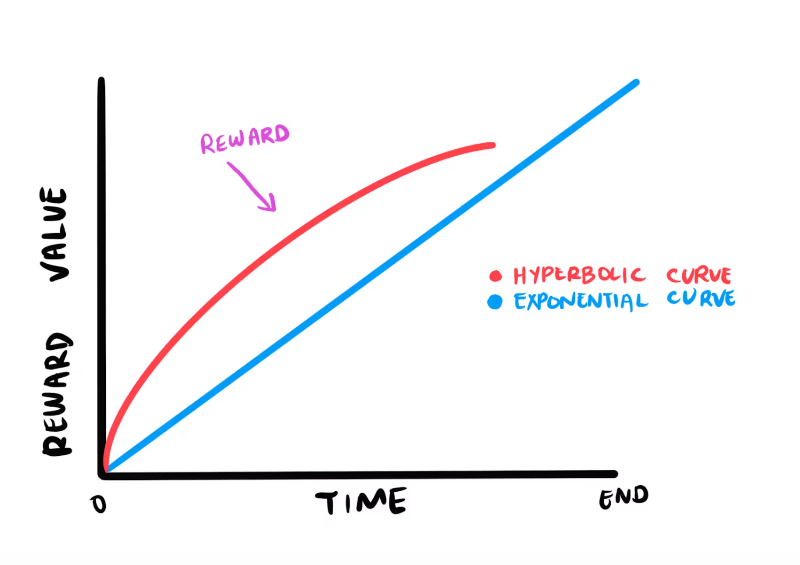
So, if entering data into an old spreadsheet takes five minutes, while learning a new dashboard takes fifteen, employees will instinctively stick with the spreadsheet, even if that dashboard will save them hours every week once they’re comfortable.
The fix is to give employees small, instant wins that make the new software feel useful right away:
- Break tasks into short, guided steps instead of lengthy product tours.
- Let employees achieve something simple on day one, like sending their first automated email or creating a basic report.
- Use checklists and onboarding progress markers so they can see how far they’ve come.
When employees feel those quick payoffs, they’re more likely to keep exploring the tool, and over time, they’ll naturally unlock the deeper, long-term benefits.
Here’s how Folk, the CRM platform, breaks down the learning curve with an onboarding checklist and interactive tutorials triggered from the checklist:

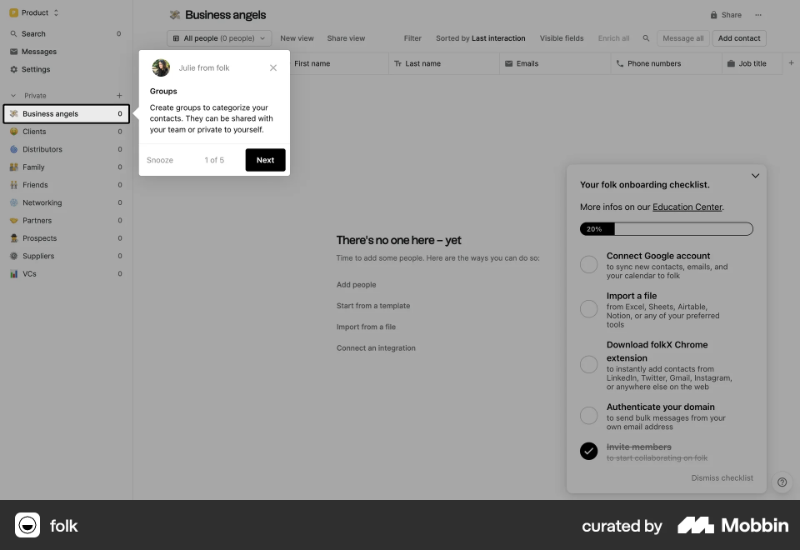
You can also use onboarding checklists to provide a clear roadmap of all the tasks employees need to complete during the onboarding and setup process.
Checklists give structure without overwhelming the user, allowing them to see at a glance what’s done, what’s in progress, and what still needs attention.
This aligns perfectly with the benefits of digital software onboarding, too.
“Instead of confusion and asking questions for the first six months and annoying everybody around them, the new employee knows exactly what they're doing and everything related to what they're doing and what they need to learn. And all the security certificates they need to get, all the access control, that's all streamlined.”
3- Role-based onboarding
Some software is adopted across multiple teams, each approaching it with their own goals, use cases, and ways of engaging with the tool.
But even when a product is primarily used within a single team, employees rarely interact with it in exactly the same way. Different roles often lean on different features, incorporate the software into distinct parts of their workflow, and care about different outcomes.
This variation is why role-based onboarding is so important.
Instead of giving everyone the same generic product tour, you guide people through the parts of the tool that actually matter to their daily work.
This keeps onboarding relevant, avoids overwhelming employees, and helps them see value faster.
This idea is backed up by the Technology Acceptance Model (TAM), developed by Fred Davis. According to this model, two key factors determine whether someone adopts a new system:

Perceived Usefulness: Does this tool make my job easier or better?
- The benefit doesn’t have to be money saved. It could be as simple as fewer repetitive tasks, faster reporting, or cleaner collaboration.
- The sooner employees see those benefits in action, the more likely they are to keep using the tool.
This also helps counter hyperbolic discounting, from the previous best practice if you remember, where people value short-term convenience over long-term efficiency.
If onboarding shows them immediate wins, they’re more motivated to stick with it.
- Perceived Ease of Use: How hard will this be to learn?
- If a system feels overwhelming, employees quickly lose confidence and revert to old habits. But when the onboarding flow is intuitive, it feels manageable and approachable.
- This reduces fear of failure and builds momentum, which is critical for adoption.
By combining role-based onboarding with these two principles, you’re essentially answering the two biggest unspoken questions every employee has:
- “Why should I bother with this tool?”
- “Can I actually figure it out without wasting hours?”
When both answers are clear and positive, adoption skyrockets.
A good example is UserGuiding’s role-specific installation guide.
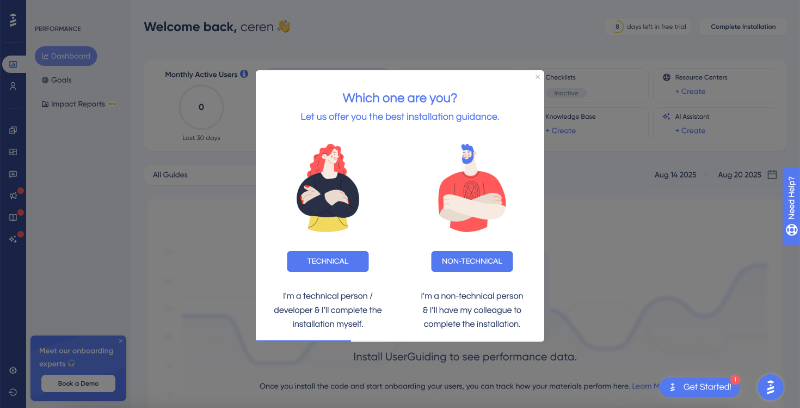
Based on the user’s answer to this initial modal (a.k.a. their role), they’re guided through either the manual setup steps or a simplified process where they can copy the code and email it directly to their developers.
Here’s an example step from the guide designed for non-technical users:

4- In-app support & guidance
Even the most motivated software user will get stuck if they don’t have the right support in place.
That’s why in-app guidance is such a game-changer.
It gives people the help they need exactly when and where they need it, without forcing them to dig through manuals or send yet another message to IT.
Think of tooltips, hotspots, and step-by-step walkthroughs as employees’ safety net. Instead of leaving them to figure out complex onboarding workflows on their own, you’re giving them small nudges in the right direction.
UserGuiding’s interactive implementation tutorial, for example.
Beside the experience being personalized and tailored to different users’ technical knowledge and comfort level, it’s also interactive and contextual with the in-app modals, and interactive tooltips.
A guide that actually walks you through the steps of doing something.
Not just instructing you to do something.
If we are to refer to another technology acceptance theory, the Unified Theory of Acceptance and Use of Technology (UTAUT) highlights just how important these support mechanisms are.
One of the theory’s key ideas is facilitating conditions.
Basically, the extent to which people feel they have the infrastructure, training, and resources they need to succeed. When employees believe help is always within reach, they’re much more likely to stick with the software.
Here’s an example interactive product tour tooltip that Figma offers to its new users as part of their product training and onboarding:

5- Provide on-demand resources
No matter how smooth your initial training is, users can still hit roadblocks or have questions on their minds along the way. They might forget an important step in a workflow, want to explore a new feature, or simply need a refresher after not touching a part of the tool for a while.
And for all of these, you need to have a self-serve knowledge base system.
Because you probably want users to feel empowered to help themselves, not go to managers or IT every time they have a question.
A well-structured standalone knowledge base paired with an in-app resource center ensures exactly that.
You can think of them as libraries that are always open with searchable FAQs, short tutorials, troubleshooting guides, and even how-to videos they can pull up without breaking their workflow.
One lives outside of your product and the other inside.
Here’s an example in-app resource center from Basecamp:
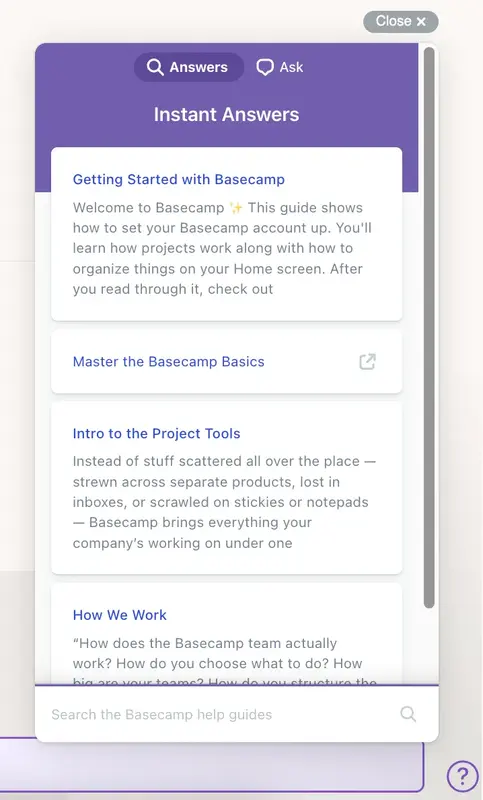
Within this resource center, the user can search for help materials and read them without leaving the app, which lowers the chances of distraction and possible friction.
Plus, all the getting-started materials, best practices, and onboarding resources for the basics are highlighted in the resource center and can be easily accessed.
6- Collect feedback early
No onboarding flow is perfect the first time around.
You’ll always discover small gaps once people actually start using the software: a step that feels confusing, instructions that are out of order, or a login detail that should have been included upfront but wasn’t. That’s why collecting feedback early is critical.
The earlier you ask employees where they’re getting stuck, the faster you can adjust and improve the experience for everyone else who follows.
In-app surveys can reveal friction points you might never have noticed otherwise.
And also the good practices.
User feedback is not always negative, you know.
Sometimes, the things people love about your onboarding can be applied to other parts of the experience as well. The key is to first identify what users appreciate and value most, and then think about how to bring more of that into your onboarding process.
Take Teamwork as an example.
They offer sample data to make it easier for new users to explore and experiment with features before migrating their real data to the platform. This allows employees to better envision themselves using the product and realizing its value.
But that’s just the assumption.
To confirm whether it holds true, they conduct an in-app survey, asking users how they feel about the sample data and whether it helped them understand Teamwork’s features more effectively.
Here’s the survey modal:

7- Add an onboarding tool to your stack
Anna Angelova, on her podcast More than Just Task Management, points out:
“Onboarding is a critical step in welcoming new employees or clients, but it often involves repetitive tasks and time-consuming processes. Automating this phase can enhance the experience while saving time and resources. For employees, onboarding often includes paperwork, training, and introductions.”
But you know what they say about repetitive tasks?
You can automate them.
For software onboarding, this means using an in-app onboarding tool like UserGuiding.
With UserGuiding, you can create interactive step-by-step guides, tooltips, hotspots, checklists, and resource centers that help new users navigate your software without constant hand-holding.
❌ No more relying solely on PDFs, emails, or live training sessions.
✅ Welcome automated, personalized, contextual in-app experiences.
Here’s an example software tour created with UserGuiding:
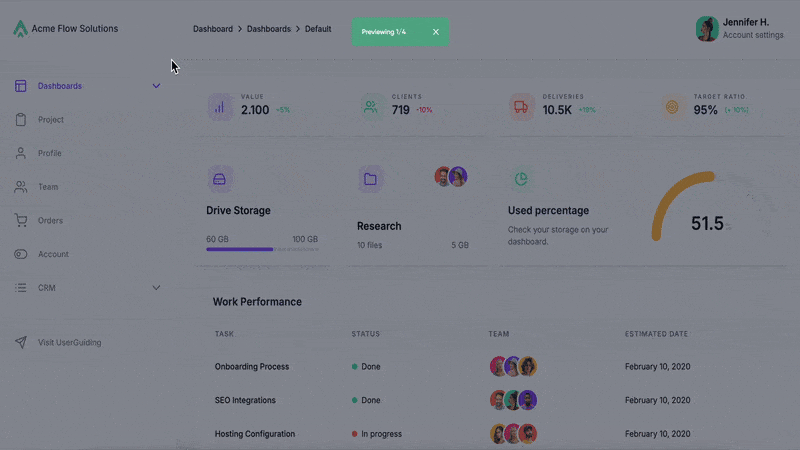
And here’s an example onboarding checklist:

With a no-code onboarding tool like UserGuiding, you can:
- 🚀 Tailor guides, tips, and walkthroughs for each team or role.
- 🚀 Empower team leaders in spotting gaps and clarifying confusing steps.
- 🚀 Use feedback to improve clarity and effectiveness.
👉🏻 Start your free trial today. 👈🏻
Success tips for implementing software onboarding
1- Keep in-app training short, interactive, and continuous
Employees tend to absorb new information more effectively when sessions are brief, hands-on, and spread over time.
So, instead of overwhelming everyone with a long, single session, breaking lessons into smaller modules or interactive demos makes learning feel manageable.
💡 Even when onboarding sessions are short and focused, a lot of the information won’t be fully absorbed immediately.
That’s why gently reminding users about pro tips, best practices, or key features over time can make a big difference.
Small, contextual nudges like hotspots, tooltips, or subtle in-app messages help reinforce learning without feeling intrusive and ensure employees steadily build confidence and familiarity with the software.
2- Leverage champions and social influence
Internal champions (team members who are familiar and confident with the software) can inspire others to explore and adopt it. Seeing peers successfully use the tool builds trust and makes the adoption process feel less intimidating.
If we are to refer back to The Unified Theory of Acceptance and Use of Technology (UTAUT), social influence is a key factor in tech adoption.
Employees are more likely to engage with a new system when they notice that colleagues, leaders, or other important figures value and use it themselves.
3- Combine formal training sessions with in-app reinforcement
Big purchase decisions often come with extensive in-person trainings, dedicated success managers, and product specialists.
But those sessions aren’t always tailored for the actual team members who use the software day-to-day.
Team leads might attend the big meetings, but what about freelancers, part-timers, or even full-time employees who weren’t in the room?
When it’s just them and the product, in-app onboarding and guidance become essential.
Tools like interactive walkthroughs can guide users step by step through key features, while tooltips, hotspots, and contextual nudges offer small, timely reminders exactly when they’re needed.
4- Celebrate quick wins
Noticing early benefits from the software, such as saving time, improving results, or streamlining a process, reinforces its value.
But even these relatively simple-looking wins can take some time to manifest themself.
They require the employee to actually use the tool, to get started.
One way to accelerate this is by highlighting early successes during onboarding, such as completing key setup steps or activating important features.
These visible milestones not only boost confidence but also create a sense of progress, showing employees that the effort they put into learning the software immediately pays off.
Toucan’s gamified onboarding experience, with points and celebratory animations, is a great example of boosting user engagement and motivation, for example:

Metrics to measure software onboarding success
- Onboarding completion rate: Measures how many employees finish the onboarding process.
Calculation: (Number of employees who completed onboarding ÷ Total employees assigned) × 100%
- Time-to-productivity: Measures how quickly employees reach proficiency with the software.
Calculation: Average time from onboarding start to employees performing key tasks independently.
- Feature adoption rate: Tracks which features employees actually use.
Calculation: (Number of employees using a feature ÷ Total employees) × 100%
- Number of support tickets before/after onboarding: Shows if onboarding reduces common questions or issues.
Calculation: Compare total support tickets submitted before onboarding vs. after.
- Employee satisfaction rate: Tracks how satisfied employees are with the onboarding experience.
Calculation: Conduct software onboarding satisfaction surveys.
To wrap up…
Successful software onboarding is critical for driving software adoption, especially during digital transformation and change management initiatives.
When employees understand and embrace new tools, organizations move faster, reduce resistance, and get more value from their technology investments.
And effective onboarding is the first step.
With the right strategies and tools, companies can achieve faster adoption, lower costs, and more empowered employees. So, exploring digital adoption platforms (DAPs) can be a great way to streamline this process and maximize software success.
And why not kick things off with UserGuiding?
Just saying 👀
Frequently Asked Questions
What is the most effective software onboarding process for remote employees?
The most effective software onboarding for remote employees combines short, interactive training sessions with continuous in-app reinforcement. Onboarding should be personalized for each role, highlighting only relevant features and workflows. Including step-by-step guides, tooltips, and checklists helps users understand and adopt the software at their own pace. Regular feedback loops and updates ensure that the onboarding stays aligned with new features and evolving workflows, reducing confusion and accelerating adoption.
How do you measure ROI of software onboarding tools in large enterprises?
ROI can be measured by tracking adoption rates, feature usage, and employee productivity improvements. Engagement with onboarding guides, checklists, and tooltips can be monitored, while surveys capture user satisfaction and confidence. Faster onboarding reduces time spent on repetitive questions and support tickets, saving costs. In large enterprises, improved adoption directly correlates with faster project execution, higher efficiency, and better utilization of the technology investment, giving a clear picture of ROI.
How do UserGuiding, WalkMe, and Appcues compare in terms of software onboarding?
UserGuiding is best for an all-in-one adoption solution, combining in-app guidance, communication, AI agents, and even standalone knowledge bases or product update pages. WalkMe shines as an employee onboarding software, offering workflow management, employee productivity, and automation features tailored for enterprises. Appcues, on the other hand, stands out for its analytics and user behavior monitoring. The right choice depends on whether you prioritize adoption breadth, workflow automation, or deep analytics.
What are the best practices for designing a scalable software onboarding process in 2025?
Scalable onboarding is about balance and automating the experience without losing personalization. You can use onboarding tools to guide users through role-specific workflows and tailor guidance to different user personas at scale. You can also deploy in-app walkthroughs, checklists, and tooltips while collecting continuous feedback through lightweight in-app surveys with these tools.
What are the role-based software onboarding strategies to improve feature adoption rates?
Role-based onboarding tailors guidance and feature explanations to specific team responsibilities. Highlighting relevant workflows reduces cognitive load and increases adoption. Interactive walkthroughs, checklists, and in-app tooltips ensure users only see what matters to their role. Personalization, combined with feedback loops, ensures employees gain confidence quickly, boosting feature adoption rates across the organization.
What are the best software onboarding tools with built-in analytics and reporting features?
UserGuiding, Appcues, Pendo, and Userpilot are strong options for onboarding with built-in analytics. Most onboarding platforms today provide material engagement tracking, showing which guides, walkthroughs, or checklists resonate with users. For teams that need more advanced dashboards, such as funnel analysis, retention cohorts, or behavioral insights, tools like Pendo or Appcues offer deeper reporting layers. The key is choosing the tool that balances usability with the level of analytics your team actually needs.
What are the common mistakes companies make during the software onboarding process?
A common mistake is overwhelming users with too much information at once, instead of delivering guidance in digestible, role-specific steps. Many companies also fail to update onboarding materials as software evolves, leaving users with outdated instructions. Others skip user feedback, missing opportunities to refine their flows. Finally, relying only on live training without in-app reinforcement can frustrate users, as retention drops quickly. Avoiding these pitfalls makes onboarding both effective and sustainable.
How do you reduce employee churn with better software onboarding experiences?
Reducing churn starts with making employees feel confident and supported from day one. Effective onboarding delivers clear, role-based guidance and reinforces it with tooltips, walkthroughs, and checklists. This reduces frustration and accelerates proficiency, making the software feel like a productivity booster rather than a hurdle. Gathering feedback and continuously improving the onboarding experience also shows employees that their needs are valued. When software feels intuitive and supportive, satisfaction rises, and churn drops.

















.svg)
.svg)
.svg)
.svg)
.svg)

.svg)
.svg)












.svg)
.svg)




.png)















